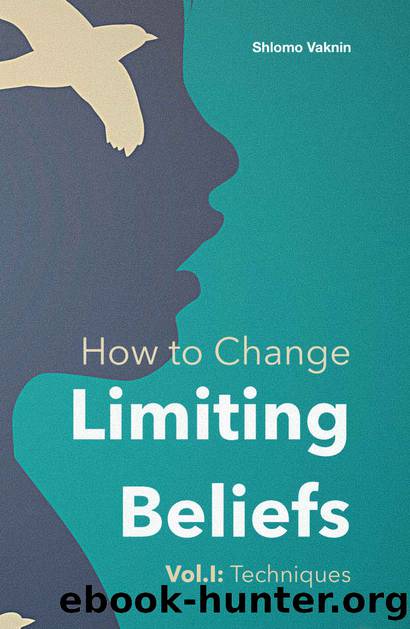How to Change Limiting Beliefs, Vol.I: Techniques by Shlomo Vaknin

Author:Shlomo Vaknin [Vaknin, Shlomo]
Language: eng
Format: epub
Tags: NLP, Beliefs, Transformation
ISBN: 9798464427952
Google: A3y7zgEACAAJ
Amazon: B09DN35F8C
Publisher: Vibhatsu
Published: 2021-08-24T18:30:00+00:00
Identity (as a helper), Skills/Knowledge (applied to helping), and Behavior (helping).
However, what if you want to improve your job prospects in order to earn more money and contribute more to society by assuming greater responsibility in your chosen field?
Assume the answer is that you should return to school to gain additional knowledge and earn an advanced certification or degree.
While you may be able to assert that this objective is connected to your identity level, this is insufficient if your understanding is purely intellectual and conscious.
If your strongest connection to school is only at a skills/knowledge level, youâre in trouble. That is because your identity level is currently occupied by actively engaging in beneficial behaviors on a daily basis.
This âIdentity overrideâ (the identity level taking precedence over the behavior level) causes you to put off returning to school while your current job consumes the lionâs share of your energy and creativity.
Establishing a Hierarchy of Criteria is a process that assists you in linking a higher level, such as your identity level, to a critical objective, such as returning to school. This generates a powerful conscious and unconscious motivation that propels you forward much more easily and creatively.
On a piece of paper, in a landscape (sideways) position, create four columns with the following headings.
Leave room at the top of the page for two items: behavior and override.
Column 1) Capability
Column 2) Belief
Column 3) Desired Behavior
Column 4) Identity
Note the desired behavior.
At the top of the page, write down a behavior that you want to engage in, but that you somehow self-prevent from carrying out. For example, studying as much as you need to.
Note the motivating factors.
In column # 1, Capability: list the factors that give you the most motivation to engage in positive behavior. Emphasize factors related to skills, possessions, and knowledge that build and result from your capability to do this behavior. For example, getting into a top-notch grad program, getting into a great career, or having a nice house. Note the strategy, meta-program patterns, and sub-modalities that tell you that each criterion is motivational. For example, the idea of a great career goes along with the eager excitement in the solar plexus. The things that feed into that positive feeling include a desirable challenge and a desire for prestige. Refer to the meta-programs appendix as needed.
Note the preventing factors.
In column # 2, belief: list the factors that prevent you from carrying out the desired behavior.
Emphasize thoughts, beliefs, attitudes, and values, including any that seem irrational. Include any resistance or objections that pop up and take you away from your desired behavior, even if you have never put them into words before.
Take yourself through the process of getting pulled away from your desired behavior and analyze it as though it was a formal decision-making process.
Look for strategies, meta-programs, and sub-modalities that drive these decisions.
Look for the criteria that the decisions are based on. For example, âI do not study as much as I need to because it is stressful and I run out of time.
Download
This site does not store any files on its server. We only index and link to content provided by other sites. Please contact the content providers to delete copyright contents if any and email us, we'll remove relevant links or contents immediately.
Foolproof Persuasion: The Visual Guide To Influencing Others Without Ever Being Wrong by Vinh Ly(1285)
Beliefs by Robert Dilts(1188)
Free Yourself from Fears by Joseph O'Connor(1182)
Neuro-linguistic Programming for Dummies by Romilla Ready & Kate Burton(1155)
Moneyball by Michael Lewis(1118)
NLP by Tom Hoobyar(1047)
Moneyball: The Art of Winning an Unfair Game by Michael Lewis(1033)
NLP For Parents by Judy Bartkowiak(997)
Mind Control Hypnosis by Dantalion Jones(954)
Dark NLP: How To Use Neuro-linguistic Programming For Self Mastery, Getting What You Want, Mastering Others And To Gain An Advantage Over Anyone by Pace Michael(945)
Neurolinguistic Programming (NLP) by Neil Shah(938)
Get Laid or Die Trying by Jeff Allen(936)
The Happiness Habit by Brian Colbert(928)
Forward: A Memoir by Abby Wambach(924)
Breaking Up with Busy by Yvonne Tally(917)
Well Designed Life: 10 Lessons in Brain Science & Design Thinking for a Mindful, Healthy, & Purposeful Life by Bobinet MD MPH Kyra(877)
Psychology: How To Effortlessly Attract, Manipulate And Read Anyone Unknowingly - Become A Master Persuader INSTANTLY by Steel Jack(853)
Transformational NLP by Carl Buchheit Ellie Schamber(830)
The PPD Learning NLP Practice Group Book: The Special Guest Sessions by Judith Lowe(786)
